全文HTML
--> --> -->由于地球大气层的吸收, 地面实验探测原初宇宙线的阈能比空间实验的高. 为了降低探测器的阈能, 研究更宽能谱范围的宇宙线, 地面实验中常有两种独立的数据采集模式, 即shower模式和scaler模式[3,6,7]. 在shower 模式中, 当满足一定的触发条件时, 详细记录次级粒子击中探测器的时间和位置信息, 并通过这些信息重建宇宙线原初粒子的簇射芯位、方向和能量. 利用shower模式的重建数据, 可开展γ天文[2,3,8]和宇宙线[9,10]相关课题的研究. 在scaler模式中, 不需要太多探测器同时被击中, 也不需要记录粒子击中探测器的时间和位置信息, 只记录固定时间间隔内到达探测器的粒子个数, 这样可大大降低探测原初宇宙线的阈能[11,12]. 通过分析scaler模式中不同多重数的计数率变化, 一方面可监测探测器的运行情况, 及时发现工作异常的探测器. 另一方面, 可研究短时标的物理爆发现象, 如10 GeV—TeV能区的γ射线暴[13,14]、与太阳活动相关的GLE事件和福布什下降现象[15]等. 分析scaler模式中的计数率变化, 还可开展宇宙线与大气物理交叉学科中相关课题的研究, 如分析雷暴期间大气电场、闪电与地面宇宙线强度变化的关联[16-18].
可见, 采集数据的shower模式和scaler模式在地面宇宙线实验中都具有重要作用. 目前, KM2A阵列中的数据触发模式只有shower模式, 在满足触发条件(400 ns时间窗口内至少有20个ED着火[5])时, KM2A探测原初宇宙线的阈能较高, 大约为10 TeV. 为了降低探测器的阈能, 开展更多低能区的物理课题, LHAASO-KM2A中急需加入scaler模式的数据触发. 本文通过Monte Carlo方法, 利用CORSIKA 软件包[19]模拟宇宙线在大气中的广延大气簇射过程, 并利用G4KM2A软件包[20]模拟KM2A探测器的响应过程, 对KM2A-ED阵列中的scaler模式进行了模拟研究.
作为LHAASO实验的主要阵列, KM2A由 5195个地面电磁粒子探测器 (ED)(见图1)、1188个地下缪子探测器 (MD)组成[22,24,25]. ED是1 m2 的塑料闪烁体探测器, 主要用于精确探测到达地面的宇宙线次级粒子 (e±, μ±和γ) 密度和时间[26]. ED探测器间采取三角形排布, 在1 km2的中心区域内间隔为15 m; 外围区域内相邻ED间距为30 m (用于判别簇射芯位是否落在了阵列内[22]), 总分布面积达到1.3 km2. 通过多个ED探测器的共同观测, 从而实现对原初宇宙线粒子的簇射芯位、方向以及能量的重建.
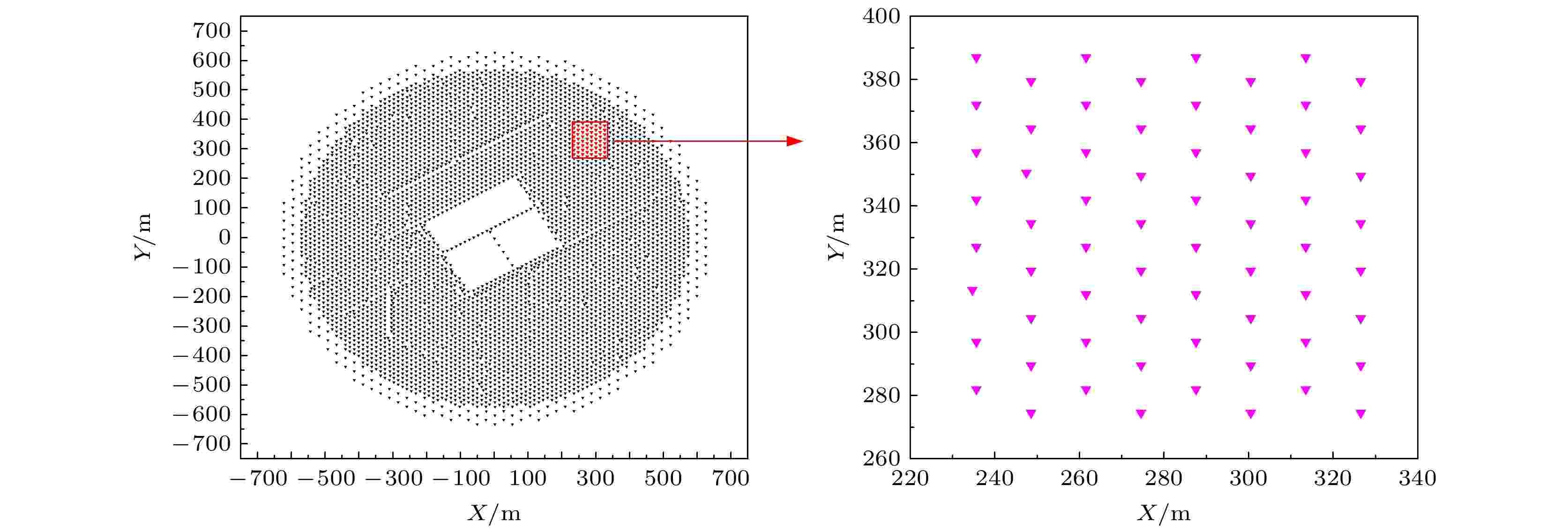 图 1 KM2A-ED阵列(左)和scaler模式中cluster的ED布局图(右)
图 1 KM2A-ED阵列(左)和scaler模式中cluster的ED布局图(右)Figure1. Layout diagram of KM2A-ED array (left) and the cluster in scaler mode (right).
LHAASO实验采取边建设边运行的模式, 利用部分阵列数据(2019年12月—2020年5月), 对标准烛光-蟹状星云10 TeV以上的伽马射线进行了研究[5], 检验了KM2A阵列的关键科学性能. 为了拓宽LHAASO实验探测原初宇宙线的能量范围, 尽早开展低能区的相关物理课题, 研究scaler模式的触发设置迫在眉睫.
在实验运行期间, 部分探测器出现故障是在所难免的, 如果将整个阵列作为一个整体来记录击中探测器的粒子个数, 将直接导致实验整体计数率出现异常. 为此, 在scaler模式的触发设置中, 需要把整个阵列分成多个小阵列(cluster)并独立计数, 以便进行数据分析时排除异常的cluster. 本文选取64个EDs (8 ED × 8 ED, 布局见图1所示) 作为一个cluster, 符合时间窗口取100 ns, 每0.1 s记录一次计数.
本文scaler模式模拟方案的具体步骤如下.
第一步: 利用CORSIKA-75700软件包, 模拟原初宇宙线进入大气层产生次级粒子的广延大气簇射过程. 考虑到原初宇宙线中主要成分是质子(Proton)和氦(Helium), 以及LHAASO观测站的截止刚度, 本文模拟研究了原初能量在14 GeV—100 TeV范围内的原初质子(能谱指数为–2.7) 和原初氦(能谱指数为–2.64)在大气中的簇射. 随着天顶角(θ)的增大, 大气层的厚度大致随着

第二步: 利用G4KM2A软件包, 模拟宇宙线次级粒子经过KM2A探测器后的响应过程. 由于芯位在阵列之外的簇射事例对scaler模式中的低多重数贡献较大, 为了收集足够多的次级粒子信息, 芯位的投点半径需要足够大. 本文在模拟探测器响应时, 投点半径取8000 m (可包含99.4%的宇宙线次级粒子).
第三步: 对模拟数据进行抽样、合并. 首先, 计算宇宙线的原初流强[28,29], 并通过泊松分布抽样, 得到一固定时间内宇宙线事例的个数. 然后, 按照指数分布对这些事例的时间间隔进行抽样. 最后, 对经过KM2A探测器响应后的宇宙线事例按照抽样得到的个数和时间进行排序, 并按照均匀分布随机投入探测器的噪声, 得到与实验相似的模拟数据.
第四步: 分析模拟数据. 对每一个cluster, 用4个计数通道分别记录多重数m ≥ 1, 2, 3和4的计数. 此处的多重数m表示在100 ns的时间窗口内, 一个cluster中被击中的ED探测器个数.
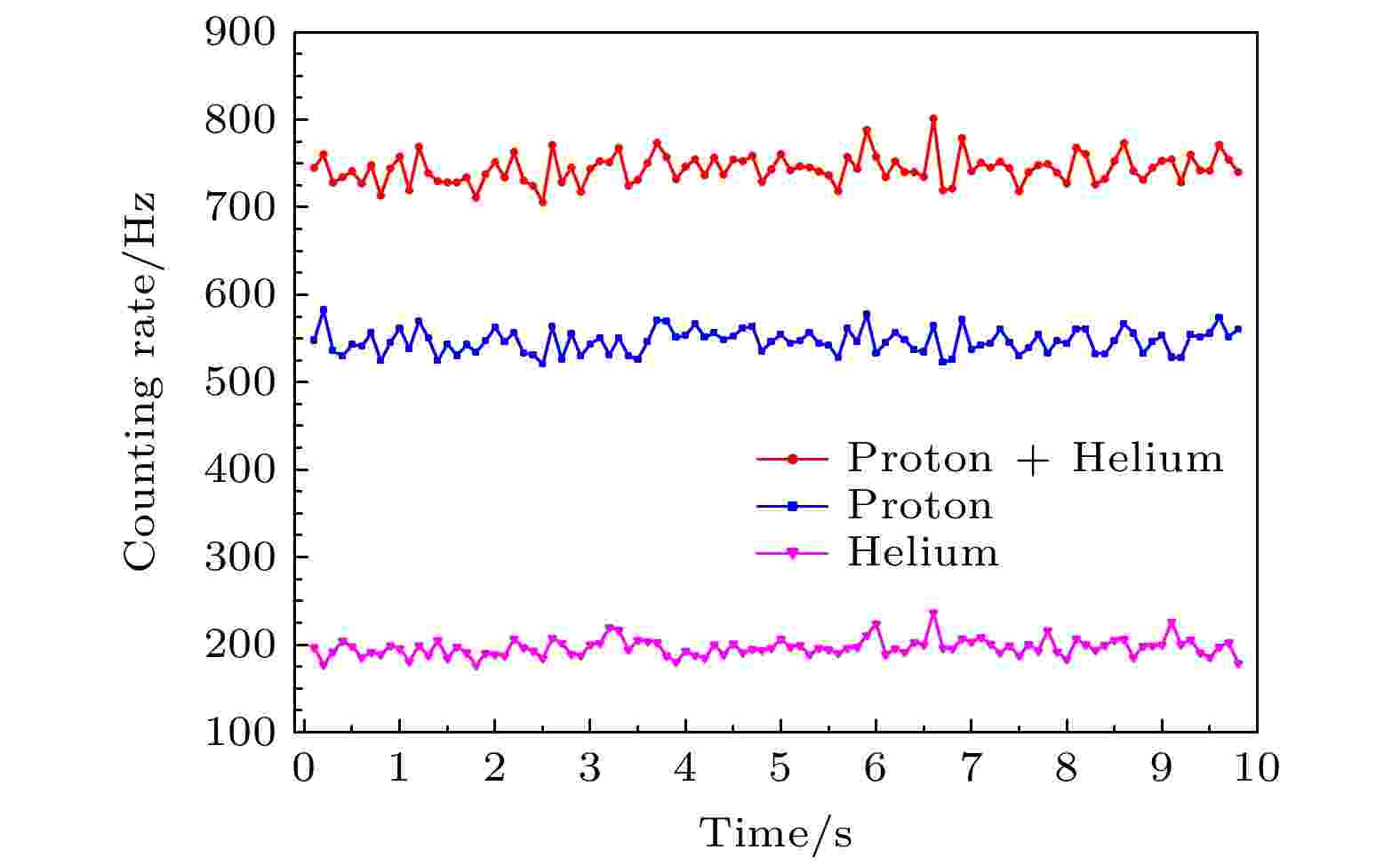 图 2 经过1个ED探测器响应后宇宙线计数率分布的模拟结果
图 2 经过1个ED探测器响应后宇宙线计数率分布的模拟结果Figure2. Event rate distribution for one ED.
2
4.1.Scaler模式中不同多重数的计数率
为了统计一个cluster中不同多重数的计数, 本文假设ED探测器的噪声为800 Hz (服从均匀分布). 当64个ED作为一个cluster、符合时间窗口为100 ns时, 图3给出了不同多重数时的计数率分布. 可见, 在scaler模式中, 随着多重数的增加, 计数率迅速减少, 不同多重数时的平均计数率见表1.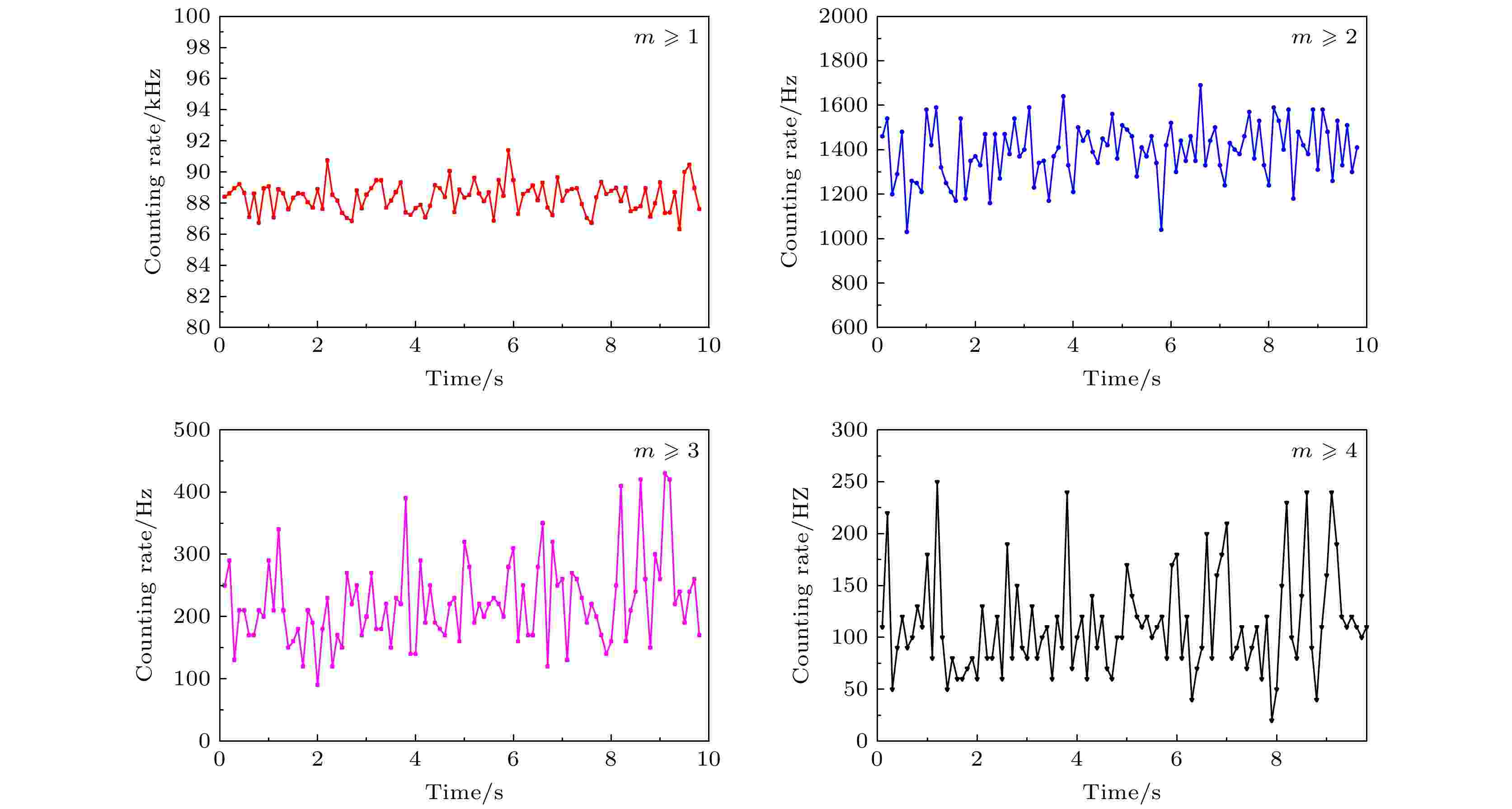 图 3 Scaler模式中多重数 m ≥ 1, 2, 3和4的计数率分布
图 3 Scaler模式中多重数 m ≥ 1, 2, 3和4的计数率分布Figure3. Event rate distribution with m ≥ 1, 2, 3 and 4 in scaler mode.
| 多重数(m) | ≥ 1 | ≥ 2 | ≥ 3 | ≥ 4 |
| 平均计数率 | 88 kHz | 1400 Hz | 220 Hz | 110 Hz |
| 宇宙线贡献率 | 42.3% | 62.3% | 96.9% | 99.7% |
表1Scaler模式中不同多重数时的平均计数率和宇宙线贡献率
Table1.Average rates and the contribution of cosmic rays in scaler mode.
ED中记录的信息不仅包含宇宙线成分, 也包含探测器的噪声. 模拟中, 宇宙线信号和探测器噪声可分别用不同的符号标注, 于是可统计出不同多重数中宇宙线的贡献率. 经模拟发现, scaler模式中多重数越大, 宇宙线成分所占的比例也越大, 详见表1. 当多重数m ≥ 3和 ≥ 4时, scaler模式中记录的粒子几乎全部源于宇宙线.
2
4.2.Scaler模式中不同多重数的有效面积
对一个地面宇宙线探测器而言, 并不是所有到达探测面的宇宙线粒子都能使探测器触发, 能准确界定探测器的探测效率(某个宇宙线粒子被探测到的条件概率)是很有意义的. 探测器的有效面积(与原初粒子的能量E、入射方向 θ 有关)可表征探测器捕捉宇宙线粒子的效率, 同时也具有面积的单位. 本文利用Monte Carlo方法, 模拟计算了scaler模式中一个cluster的有效面积Aeff(E, θ), 其关系式可表示为

图4所示为KM2A-ED阵列中不同多重数时一个cluster探测原初质子和氦的有效面积随原初能量的分布. 可以看出, scaler模式中有效面积随原初能量的增加而增加, 如在m ≥ 1时, 原初质子能量为20 GeV的有效面积约 58.65 m2、原初能量为700 TeV时约 3.75 × 106 m2. 同时, 随着多重数增大, 有效面积将减小, 如在原初氦能量为2.2 TeV时, m ≥ 1的有效面积约1.31 × 104 m2, m ≥ 4 时下降为约 29.2 m2.
 图 4 Scaler 模式中不同多重数时有效面积随原初能量的分布 (a)质子; (b)氦
图 4 Scaler 模式中不同多重数时有效面积随原初能量的分布 (a)质子; (b)氦Figure4. The Aeff as a function of the primary energy in scaler mode: (a) Proton; (b) Helium.
图5给出了原初能量在14 GeV—100 TeV范围内、不同多重数时一个cluster探测原初质子和氦的有效面积随天顶角的分布. 可以看出, scaler模式中有效面积随天顶角的增加而减小, 如在m ≥ 1时, 天顶角为5°的有效面积约 266.88 m2、天顶角为65°的有效面积约22.45 m2. 同时, 随着多重数增大有效面积也将减小, 如原初氦天顶角为5° 时m ≥ 1的有效面积约159.04 m2, m ≥ 4的有效面积约 0.59 m2.
 图 5 Scaler模式中不同多重数时有效面积随天顶角的分布 (a)质子; (b)氦
图 5 Scaler模式中不同多重数时有效面积随天顶角的分布 (a)质子; (b)氦Figure5. The Aeff as a function of the zenith angle in scaler mode: (a) Proton; (b) Helium.
当原初能量区间为14 GeV—100 TeV、天顶角在0°—70°范围内时, 根据图4和图5的结果, 可计算出scaler模式中不同多重数对应的平均有效面积


| 多重数(m) | Proton: $ \langle $Aeff$ \rangle $ /m2 | Helium: $ \langle $Aeff$ \rangle $ /m2 |
| ≥ 1 | 129.69 | 73.07 |
| ≥ 2 | 2.38 | 0.91 |
| ≥ 3 | 0.67 | 0.49 |
| ≥ 4 | 0.34 | 0.27 |
表2Scaler模式中探测原初质子和氦的平均有效面积
Table2.Average effective area for primary Proton and Helium in scaler mode.
2
4.3.Scaler模式中不同多重数探测到的原初宇宙线能量
降低探测器的阈能是地面宇宙线实验的一个重要目标. 在scaler模式中, 由于不需要太多探测器同时被击中, 即不需要满足高多重数的触发条件, 可降低探测原初宇宙线的阈能. 本文通过模拟, 得到了scaler模式中不同多重数时探测到的原初质子(图6)和原初氦(图7)的能量分布.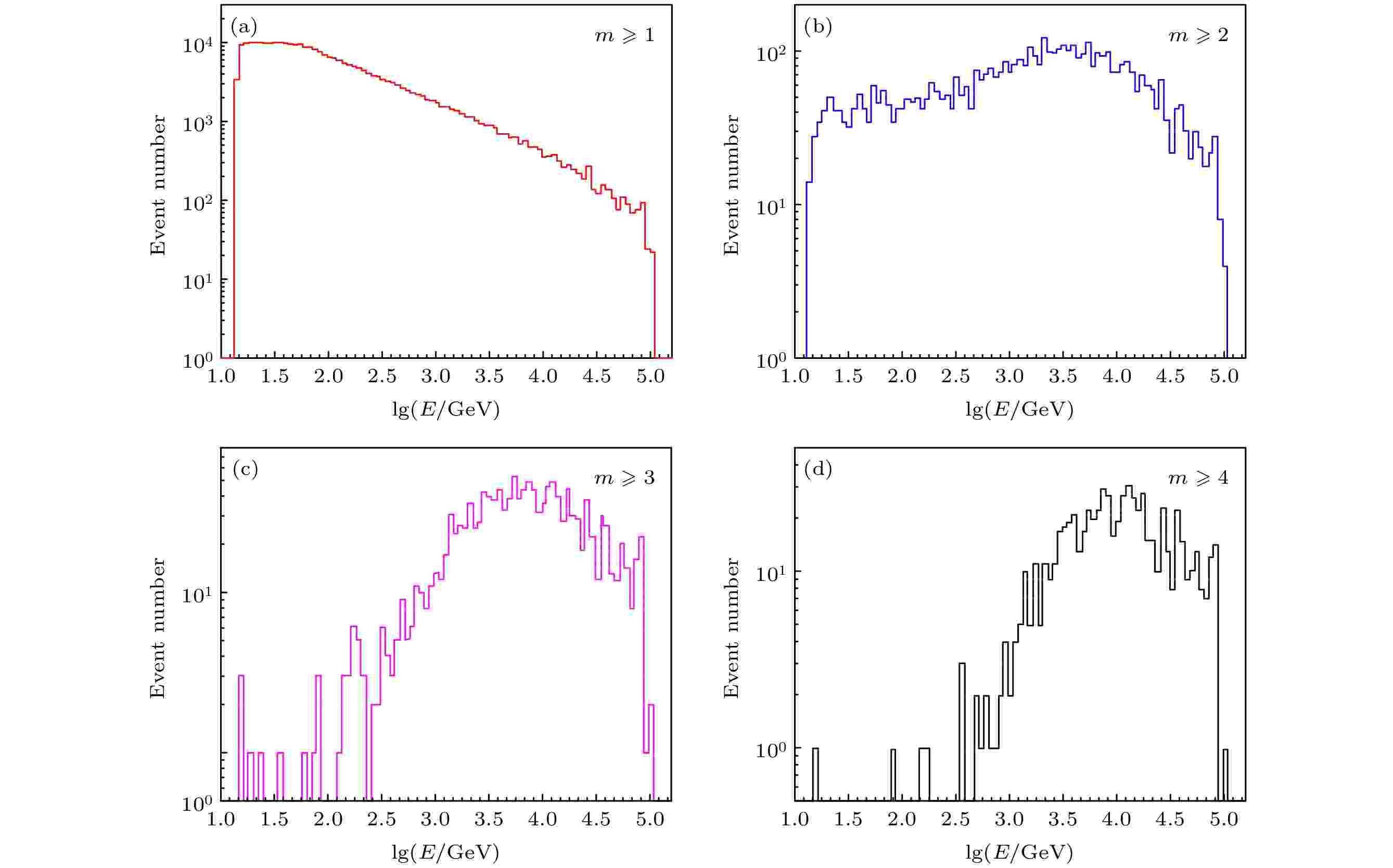 图 6 Scaler 模式中不同多重数时探测到的原初质子能量分布
图 6 Scaler 模式中不同多重数时探测到的原初质子能量分布Figure6. Energy distribution for primary Proton in scaler mode.
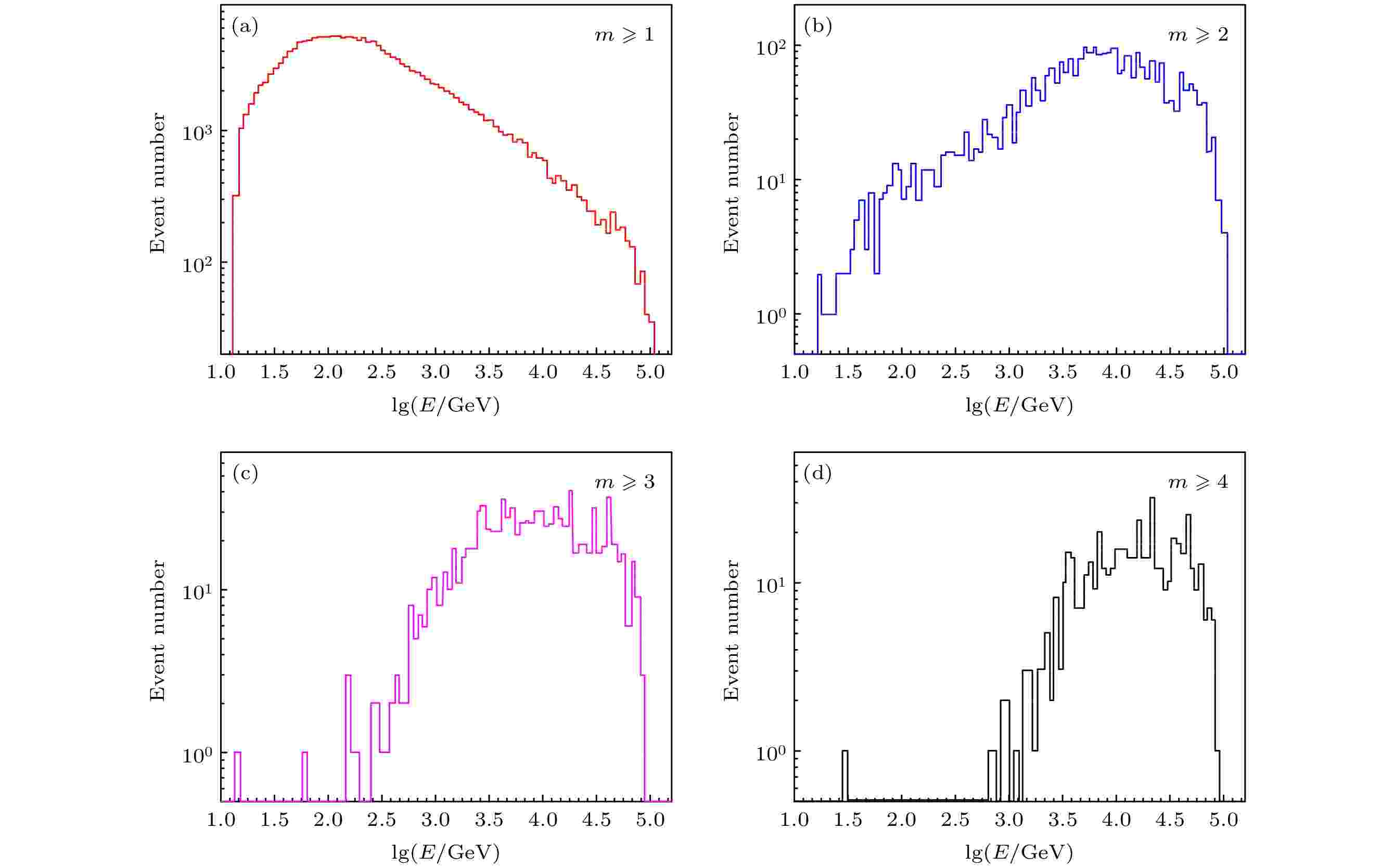 图 7 Scaler 模式中不同多重数时探测到的原初氦能量分布
图 7 Scaler 模式中不同多重数时探测到的原初氦能量分布Figure7. Energy distribution for primary Helium in scaler mode.
由图6和图7可知, 在ED阵列的scaler模式中, 探测原初宇宙线粒子的能量与多重数、原初粒子的类型有关, 多重数m越大, 探测到的原初粒子能量就越大; 当多重数相同时, 探测到的原初质子能量比原初氦的小. 表3是scaler模式中不同多重数时探测到的原初质子和氦的平均能量


由表3可知, 在KM2A-ED阵列的scaler模式中, 当多重数m ≥ 1时探测到的原初质子平均能量约94 GeV, 与ARGO实验scaler模式(一个cluster由12个RPC探测器组成, 面积为5.7 m × 7.6 m)中m ≥ 1时探测原初宇宙线粒子的平均能量(约100 GeV[32])相当. 与shower模式相比, KM2A-ED阵列scaler模式中m ≥ 1时降低了探测器阈能约两个数量级.
| 多重数(m) | Proton $ \langle $E$ \rangle $/GeV | Helium $ \langle $E$ \rangle $/GeV |
| ≥ 1 | 93.8 | 236.0 |
| ≥ 2 | 1.4 × 103 | 5.4 × 103 |
| ≥ 3 | 6.3 × 103 | 1.4 × 104 |
| ≥ 4 | 9.5 × 103 | 1.9 × 104 |
表3Scaler模式中探测原初质子和氦的平均能量
Table3.Average energy of primary Proton and Helium in scaler mode.
当64个ED作为一个cluster、符合时间窗口为100 ns时, 多重数m ≥ 1, 2, 3和 4的计数率分别为 88 kHz, 1400 Hz, 220 Hz和110 Hz; 随着多重数的增加, 宇宙线成分的贡献率越高, 当多重数m ≥ 3 时, scaler模式中的计数几乎完全源于宇宙线.
通过对不同多重数时探测原初宇宙线能量和有效面积的模拟, 发现scaler模式中多重数m ≥ 1时, KM2A探测原初宇宙线的阈能可降低两个数量级, 达到100 GeV; 一个cluster的有效面积高达100 m2.
迄今为止, LHAASO-KM2A中的数据触发模式只有shower模式. 依据本模拟结果, 在LHAASO实验中进行scaler模式的数据触发时, 可选取64个ED作为一个cluster、符合时间窗口取100 ns, 对每一个cluster用4个通道分别记录多重数m ≥ 1, 2, 3和 4的计数. 本模拟结果还可为后续的数据分析和物理研究提供参考.
感谢中国科学院高能物理研究所何会海研究员和顾旻皓副研究员在scaler模式的模拟方案和参数设置部分给予的帮助和讨论, 感谢LHAASO合作组全体成员的帮助.
